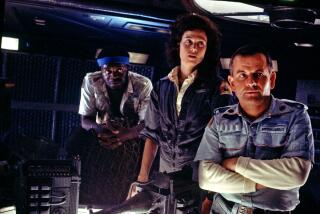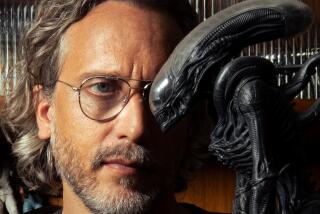MOVIE REVIEWS : ‘Alien 3’: The Ultimate Duel
Full of clanging corridors, belching furnaces and ravaging monsters, the cavernous maze-world of “Alien 3” (citywide) is not only seemingly the last stop for the entire “Alien” series--it looks like civilization’s last stop as well.
In a way, that’s what this erratic, ambitious super-thriller is about. It’s not just the ultimate duel between Sigourney Weaver’s beleaguered Ripley and the kill-crazy extraterrestrials that have chased her through three hellacious movies, it’s about running into the ultimate cul-de-sac.
“Alien 3” isn’t a classy, visionary nightmare like Ridley Scott’s 1979 “Alien” and it’s not really a hell-for-leather, super-tech toboggan ride like James Cameron’s 1986 “Aliens.” It has a different mood than either of its predecessors, and a different look: stylish but gloomy, portentously grim. It does succeed in rounding the three movies off, not smashingly but interestingly. As written by longtime “Alien” producers Walter Hill and David Giler--with Larry (“Hunt for Red October”) Ferguson--it’s partly another thrill-and-gore ride, partly an attempt at more intellectual-spiritual horror. It’s a film about humans and the universe--and, of course, Ripley--at the end of their rope. The world where it’s set, Fiorina 161-where Ripley lands after another deep-sleep space ride--is a combination refinery-prison, inhabited exclusively by prisoners and guards. There’s no future in Fiorina--it’s been mostly evacuated--and no sex. Most of the prisoners, led by the rapist-turned religious guru Dillon (Charles S. Dutton of “Roc,” a powerful, insistent presence), have taken a vow of celibacy.
There’s a brutal warden (Brian Glover), a kind, once-drunken medico (Charles Dance) and some horrific thugs--a standard-issue adventure-movie prison crew, actually, made a little tonier by the fact that most of the inmates have British accents. They tend to hail from London theater and movies like “Withnail and I” (Paul McGann and Danny Webb).
That toniness doesn’t extend to the dialogue--as before, it’s comic-book level, maybe slightly above average--but it’s reflected in the decor, the whole gray-grisly, machine-blue look of the place, and in the tilted angles that first-time director David Fincher often uses to take in vast panoramas of the tiers, tunnels and sewer-like immensities.
The visuals and the accents suggest class, and so does Sigourney Weaver. Her image is as vital as her acting--which, again, is excellent. With her tall, patrician ice-princess looks, her doe eyes, assertive chin and air of soft but sturdy composure, Weaver’s Ripley is spectacularly out of place in this three-film world of ick-bug rampages, high-tech blasters and brawling men. She’s like a socialite thrown into a monster bash: the ultimate Dish out of water. And these movies--by subjecting her to the worst indignities and terrors imaginable--seem calculated assaults on that cool, unapproachable image.
The movies are built around the idea of assault. All three of them play with the terror of the invasion of the body: the monster erupting out of John Hurt’s chest in “Alien” and the nightmare of one growing in Ripley’s body that’s used both in “Aliens” and here.
In “Alien,” Ripley was part of a fairly civilized professional flight crew; in “Aliens,” she fell among super-macho grunts. Here, she’s in an all-male prison-world so degraded and lice-ridden that everyone’s head--including hers--has to be shaved. There’s a concentration-camp look about the place, heightened by the fact that it’s run by the mysterious Company, for whom everyone is expendable.
Fincher has good designers and a great cinematographer--Alex Thomson, who lit “Excalibur” for John Boorman--and he’s obviously trying for something closer to Scott’s “Alien” than Cameron’s. A rock video specialist, he wants eerie Gothic chic instead of a slam-bang, cleanly lit apocalypse; he wants his images to have a shine, a pizazz, a depth. But, although “Alien 3” is stylish--and ambitious--the movie doesn’t have the soul or guts to sustain that ambition. It gets swallowed up in its own technology and genre expectations. And Fincher gets stalled in the drama, trapped in too many scenes of talking heads looming out of the gloom.
The best science-fiction literature--by Philip Dick, Phillip Jose Farmer, Theodore Sturgeon, J. G. Ballard, Robert Silverberg or Robert Heinlein--is about ideas, and so are the best science-fiction movies: “2001,” “Blade Runner,” “Brazil” and Andrei Tarkovsky’s “Solaris” and “Stalker.”
But, especially after the ‘80s, most science-fiction movies have been about monsters and machines. It’s probably too late for “Alien 3” to step a little outside the tide--even if the script had more substance, the style more control.
The underlying theme of all the “Alien” movies, the distant glossy ancestors of Howard Hawks’ 1951 “The Thing,” is the rot in the technology, bugs-against-machines.
In a way, this “Alien” capstone is about the end of everything, a technological and spiritual meltdown--which, considering the social and governmental breakdowns all around us, may be appropriate to 1992. But, however much it tries, the movie can’t escape the bugs in its own machine: the money-driven monsters that keep driving it into infernal cul-de-sacs.
‘Alien 3’
Sigourney Weaver: Ripley
Charles S. Dutton: Dillon
Charles Dance: Clemens
Lance Henriksen: Bishop II
A 20th Century Fox presentation of a Brandywine production. Director David Fincher. Producers Gordon Carroll, David Giler, Walter Hill. Executive producer Ezra Swerdlow. Screenplay by Giler, Hill, Larry Ferguson. Cinematographer Alex Thomson. Editor Terry Rawlings. Costumes Bob Ringwood, David Perry. Music Elliot Goldenthal. Production design Norman Reynolds. Art director James Morahan. Set decorator Belinda Edwards. Running time: 1 hour, 45 minutes.
MPAA-rated R (Monster violence, language).
More to Read
Only good movies
Get the Indie Focus newsletter, Mark Olsen's weekly guide to the world of cinema.
You may occasionally receive promotional content from the Los Angeles Times.








